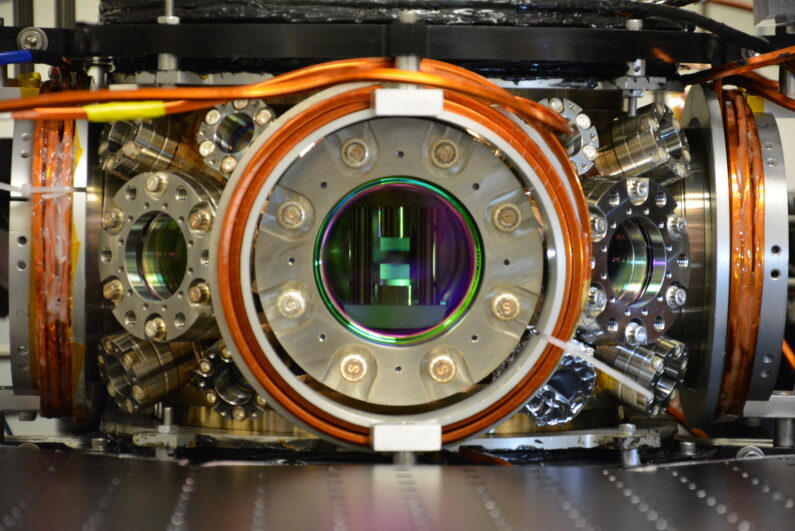创新背景
光学晶格是一种使用激光光束的交错网格,以一种类似晶体的有序方式排列原子。该工具通常用于研究具有重复几何形状的固体和其他相物质的基本特性。然而,由于缺乏这种新体系的特殊弹性,这些晶格的一个缺点是它们是无声的。
创新过程
为了建立这个装置,研究人员用超冷的铷量子气体填充了一个空的镜腔。就其本身而言,这是一种超流体,是一种物质的相,其中的原子可以无阻力地涡旋流动。当暴露在光下时,铷超流体会自发地重新排列成超固体——这是一种罕见的物质相,同时显示出在晶体中看到的顺序和超流体的非凡流动性。

将声音带进腔体的是两块精心间隔的凹面镜,它们的反射性非常强,以至于一个光子穿过它们的几率只有1%。反射率和特殊的几何结构——弯曲镜的半径等于它们之间的距离——使得泵入腔内的光子经过原子超过10,000次。在这个过程中,光子与原子形成了一种特殊的紧密键,迫使它们排列成晶格。
研究人员使用的腔体在镜子之间来回反射的光线形状方面提供了更大的灵活性。这种特殊的腔体允许超流体原子(超固体)晶格四处移动,因此,与其他光学晶格不同的是,它在被戳时可以自由扭曲——这就产生了声波。为了启动声子通过弹性晶格的发射,研究人员使用了一种叫做空间光调制器的仪器来戳它,这使他们能够对注入腔内的光进行不同模式的编程。

研究人员通过捕捉出腔的光的全息图来评估这是如何影响腔内内容物的。全息图记录光波的振幅和相位,使声子得以成像。除了调解有趣的物理,设备内部的高曲率镜子产生高分辨率图像,就像显微镜,这使得研究人员将他们的发明命名为“活性量子气体显微镜”。
研究人员确认了设备中声子的存在,通过发送不同模式的光并测量,再将其与戈德斯通色散曲线进行比较。这条曲线显示了包括声音在内的能量是如何在晶体中运动的;他们的发现与之相符的事实证实了声子和振动超固态的存在。
创新关键点
为了建立新型装置,研究人员用超冷的铷量子气体填充了一个空的镜腔。就其本身而言,这是一种超流体,是一种物质的相,其中的原子可以无阻力地涡旋流动。当暴露在光下时,铷超流体会自发地重新排列成超固体——这是一种罕见的物质相,同时显示出在晶体中看到的顺序和超流体的非凡流动性。
创新价值
研究人员未来能将这项发明应用到许多方面,包括研究超导体的物理学和创建量子神经网络。
Innovative development of "Quantum Simulator" to provide audio dimension to "optical lattice"
To build the device, the researchers filled an empty mirror cavity with ultra-cold rubidium quantum gas. By itself, this is a superfluid, a phase of matter in which atoms can flow in a vortex without resistance. When exposed to light, rubidium superfluids spontaneously rearrange into supersolids - rare phases of matter that simultaneously display the order seen in crystals and the extraordinary mobility of superfluids.
Bringing sound into the cavity are two carefully spaced concave mirrors that are so reflective that a photon has only a 1% chance of passing through them. The reflectance and special geometry - the radius of the curved mirror is equal to the distance between them - allow photons pumped into the cavity to pass through the atom more than 10,000 times. In the process, the photons form a special kind of tight bond with the atoms, forcing them to arrange into a lattice.
The cavity the researchers used provides more flexibility in the shape of the light that bounces back and forth between mirrors. This particular cavity allows the lattice of superfluid atoms (supersolids) to move around, so that, unlike other optical lattices, it is free to twist when poked - which creates sound waves. To initiate phonon emission through the elastic lattice, the researchers used an instrument called a spatial light modulator to poke it, which allowed them to program the light injected into the cavity in different modes.
The researchers used holograms that captured the light coming out of the cavity to assess how this affected the contents of the cavity. Holograms record the amplitude and phase of light waves, allowing phonons to be imaged. In addition to mediating interesting physics, a high-curvature mirror inside the device produces high-resolution images, much like a microscope, which led the researchers to name their invention "active quantum gas microscopy."
The researchers confirmed the presence of phonons in the device by sending different patterns of light and measuring them, then comparing them to Goldstone dispersion curves. This curve shows how energy, including sound, moves through the crystal; The fact that their findings match that confirms the existence of phonons and vibrational supersolids.
智能推荐
量子计算+机械工程 | 开发原型谐振器技术用于控制自旋量子比特
2022-09-22来自新南威尔士大学悉尼分校的量子工程师们扫除了量子计算机成为现实的一个主要障碍:他们发现了一种新技术。该技术将能够控制数百万个自旋量子位——硅量子处理器中的基本信息单位。
涉及学科涉及领域研究方向新建“量子级热泵”可提高射频信号测量准确性
2022-09-06涉及学科涉及领域研究方向量子计算+原子物理 | 创新利用“碱土原子”实现量子特定计算
2022-10-24加州理工学院的一个量子物理学家团队在使用一种更复杂的中性原子(位于元素周期表第二列的碱土原子)的研究上取得了进展。
涉及学科涉及领域研究方向